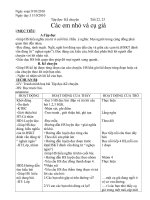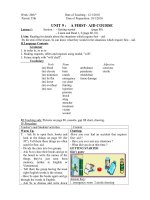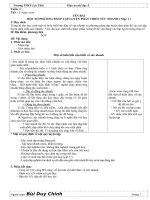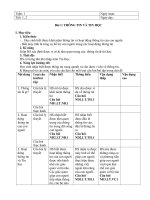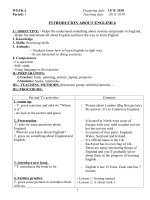Giáo án anh 8 soạn theo tập huấn mới 5 hoạt động
Bạn đang xem bản rút gọn của tài liệu. Xem và tải ngay bản đầy đủ của tài liệu tại đây (203.96 KB, 15 trang )
Week:6
Period: 16
UNIT 3: People of viet nam
Lesson 1:Getting-started
Writing date:
Teaching date:
I./. Objectives
1. Knowledge: By the end of the lesson, students will be able to listen and read for
specific information about cultural groups of Viet Nam, practice listening and
speaking with the lexical items related to cultural groups of Viet Nam
- Vocab: cultural groups of Viet Nam
- Grammar
2. Skills: Speaking, listening, reading, writing.
3. Attitude: - Positive about people of VietNam.
- Students know how to learn English in right way.
4. Competence: Communication, self-learning capability, creative capacity, ability
to use of language……
II./.PREPARATION:
1. Teacher: book, planning, picture, laptop, projector
2. Students: books, notebooks
III./. TEACHING METHODS: Communicative approach, group activities, play
as a character, teaching methods with game, teaching methods by visual, teaching
methods by practising, discussion group, technical present….
IV./. Procedure
Teacher and student’s activities
1. Warm up (5'): Describe pictures
- Review the previous unit by asking Ss to
solve a crossword puzzle. Draw the
crossword on a big piece of paper. Tell Ss that
the red word is the key word of the new
lesson. Divide the class into two teams. Ss
from each team take turns to solve the puzzle.
The game finished when a student guesses the
red word correctly.
- Solve the crossword puzzle below.
1.I like to……buffaloes in the pastures.
2.The farmers are very busy during
harvest…..
3.Have you ever ridden a….? You have to be
brave to do it.
4.People in the countryside are often open
and….
5…..was loaded onto a cart and transported
home.
6.I think….life is more interesting than city
1
Content
- work in groups
KEY:
1.Herd
2.Time
3.Horse
4.Friendly
5.Rice
6.Country
.
life.
- Write the unit title on the board. Write the
words/phrases ‘ethnic’, ‘ethnology’, and ask
Ss to guess their meaning. T may also show a
picture of a typical costume and talk about it
with the Ss.
2. Presentation (10')
2.1. Vocabulary
- Teacher use different techniques to teach
vocabulary (situation, realia)
- Follow the seven steps of teaching
vocabulary
* Checking vocab: Recall
- curious (a)
- account for (v)
- ethnic (a)
- minority (n)
- region (n)
- custom (n)
-awesome (a)
- terraced field (n)
- heritage site (n)
- Repeat in chorus and
individually
- Copy all the words
2.2. Listen and read
* Set the scenes:
Ask Ss to open their books to the lesson. T
can ask Ss prediction questions. For more
able classes, T can brainstorm questions with
Ss and write them on the board. Questions
may include:
•What can you see in the picture?
•What can you see in the picture?
•What can you see in the picture?
•Do you know these characters?
•Where are they now?
•What are they talking about?
Ss answer questions as a class.
T plays the recording and has Ss
follow along. T may want to ask
Ss to track the dialogue with
their fingers as they listen to the
recording. Then come back to
the earlier questions and have
Ss answer them again. Do not
give correction at this stage.
- Listen and read
3. Practice (20'')
3.1. Find the opposite of these words in the
conversation
- individual work
- Ask Ss to the read the conversation again
2
and do the exercise in pairs or in groups. T
writes the correct answers on the boards.
? Work individually.
? Share answers with your partner.
- Teacher gets feedback
3.2. Read the conversation again and
answer the questions
- Go through the questions mentioned
- Have Ss work individually to answer the
questions. Ss compare answers with a partner
and then discuss as a class. Then correct the
answers.
- (c)Tell Ss to refer back to the conversation
to find the expessions. Together with the Ss,
elicit the meaning of these four expressions.
Then give examples. For more able classes,
have the Ss provide the examples of when
these expressions would be used.
3.3. Work in pairs.
- Ask Ss to role-play the example
conversation in pairs before creating their
short role-plays. More able Ss can try to
extend the conversation.
Encourage Ss to use How + as many
adjectives as possible.
3.4. Use the words and phrases in the box...
(2 P27)
- Ss work in pairs and label each picture.
Then let Ss read each word/phrase correctly.
Check and correct their pronunciation.
3
Key:
1.interesting
2.largest
3.minority
4.southern
Key: 1. They are in the
Museum of Ethonology.
2. They want to know
about the ethnic groups of Viet
Nam.
3. There are 54
( ethnic groups ).
4. The Viet (or Kinh)
have the largest population.
5. Yes, they do.
Key
1.Used as a reply, agreeing with
what sb has just said,or
emphasizing that it is correct.
2. How + adj/adv : used to
show a strong reaction to sth
3. Used to show you understand
what someone said
4. Used to show that you think
something is great
Look out!
Help Ss distinguish the two
words.
‘people’ is used as the plural of
‘person’ to refer to men,
women, and children
‘people’: ethnic groups of
people who belong to a
particular country, race, or area
Key: 1. five-coloured stickey
rice
2. terraced fields
3. festival
4. folk dance
5. Open-air market
6. Musical instrument
7. costume
8. stilt house
3.5. Complete the sentences (3 P27)
? Work individually to do the task then
compare their answers with a partner.
- Ss do the task by themselves. After that they
swap their answers with a partner. T corrects
as a class. Then let them repeat the
words/phrases in chorus.
4. Pracice ( 6') Game: Quick quiz
Ask ss to work in pairs. Ask and answer,
using these cues. Ss work in pairs to ask and
answer the questions. T gives correction. T
may call on some pairs to talk before the
class.
5. Production: (2')
? Learn by heart all the new words.
? Do Ex (Workbook)
? Prepare: Closer Look 1
- Collect pictures, songs, clips talking about
people of Viet Nam
Key:
1.ethnic
2.heritage site
3.stilt houses
4.festivals
5.member
6.terraced
fields
Key:
1. Which ethnic group
has the smallest population?
2. Do the Hmong have their
own language?
3. Where do the Coho live?
4. What colour is the Nung’s
clothing?
5. Which group has a ;arger
population, the Tay or the Thai?
6. Whose arts are displayed at a
museum in Da Nang?
- Take note
----------------------@0@------------------Week:6
Period:17
UNIT 3: People of viet nam
Lesson 2: A closer look 1
Writing date:
Teaching date:
I./. Objectives
1. Knowledge: By the end of the lesson, ss will be able to:
- Pronounce words containing clustes /sk/,/sp/, and /st/ correctly in isolation
and context
- Use the lexical items related to cultural groups of Viet Nam
- Vocab: cultural groups of Viet Nam
- Grammar: Simple present
2. Skills: Speaking, listening, use of English
3. Attitude: - Positive about people of VietNam.
4
- Students know how to learn English in right way.
4. Competence: Communication, self-learning capability, creative capacity, ability
to use of language……
II./.PREPARATION:
1. Teacher: book, planning, picture, laptop, projector
2. Students: books, notebooks
III./. TEACHING METHODS: Communicative approach, group activities, play
as a character, teaching methods with game, teaching methods by visual, teaching
methods by practising, discussion group, technical present….
IV./. Procedure
Teacher and student’s activities
1.Warm up(5'): Brainstorming
- Divide the class into 2 two teams
-Ss brainstorm the names of the ethnic
groups they know where they live, their
costumes, their way of life, culture, folk
songs…Encourage them to guess and
call out as many words as possible- In 4
minutes the team with more right
words is the winner.
- Introduce the new lesson
The new leson
2.Vocabulary (20')
* Teaching vocabulary
- Teacher use different techniques to
teach vocabulary (situation, realia)
- Follow the seven steps of teaching
vocabulary
* Checking vocab: Slap the board
Content
- Take part in the game in 2 teams
-developed (a)
- insignificant (a)
-complicated (a)
-major (a)
-minor (a)
-basic (a)
- Repeat in chorus and individually
- Copy all the words
2.1.Match the adjs in A with their
opposites in B (P28)
- T may explain and give examples of
adjectives. Ask Ss to give some more
- Check understanding of these words.
-Elicit ideas from the Ss. Say. for
example,
- Go through all the words in this way to
make sure understands them.
- If there is time, advanced Ss can write
the words in sentences (or homework).
2.2. Use some words from 1 to
complete the sentences (p28)
-Ss work in pairs to match the
adjectives with their opposites. T elicits
the answers from the class.
Key: 1.d
2.c
3.g
4.a
5.f
6.e
7.b
-Ss work individually to do the task.
5
-Get Ss to work individually.
- Ss compare their answers with a
partner and then discuss as a class.
- There may be some variations in the
answers. For a more able class,
encourage Ss to explain why they
choose that word for the category.
- Check their answers.
2.3. Work in pairs. Discuss what the
word is for each picture......(p 28)
- Ask Ss work in pairs. When they have
finished, let them exchange their
answers with a partner/ another pair.
- Check the answers with the class. For
more able Ss, ask them to give other
words they know which are related to
the life of ethnic minority people.
- Then T elicits the correct answer.
Some Ss may write the answers on the
board.
Key:
Key:
1.written
2.trasitional
3.important
4.simple, basic
5.rich
-Ss work in pairs and discuss what the
words is for each picture
Key: 1.ceremony
2.pagoda
3.temple (Ly Son)
4.waterwheel (in the north)
5.shawl (of the Thai women)
6.basket (of the Sedang)
3. Pronunciation (15'')
Clusters: /sk/, /sp/, and /st/
3.4.Listen and repeat the words( P28)
-Ask Ss to listen and repeat.
-Pause the recording to drill difficulty
items.
-Have Ss say the words individually
-Listen and repeat
Audio script: skateboard
stamp
speech
display
first
station
Instead
crisp
school
basket
space
task
3.5. Listen again and put them in the
right...
( P28)
- Play the recording again. Ss listen
carefully and put the words in the right
columns. Note that ‘school’ may cause
some confusion because the sounds of
/sk/ are spelled with the letters ‘sch’.
Ask Ss to give other words which
contain these clusters.
- Do the task individually
Key :
/sk/
/sp/
3.6. Listen and read......
- Play the recording two or three times
(or more if necessary). Help Ss
recognize all the words with
/sk/,/sp/,or /st/, then underline them as
- Listen and repeat
.
Key: 1. The Hmong people I met in Sa
Pa speak English very well
2. You should go out to play instead of
6
/st/
skateboard Speech
Stamp
School
Display
First
Basket
Crisp
Station
task
Space
Instead
assigned.
staying here.
3. This local speciality is not very
spicy.
4. Many ethnic minority students are
studying at boarding schools.
5. Most children in far-away villages
can get schooling.
4. Further practice (3')
-Ask ss to find some more words that
- Answer teacher's questions.
have these clusters: /sk/, /sp/, and /st/
- Say out the words
5. Production (2')
- Learn by heart all the new words.
- Guide ss how to do Exs (workbook) - Take note
- Prepare: Unit 2: Closer Look 2
- Collect pictures, songs, clips talking
about people of Viet Nam
----------------------@0@------------------Week:6
Period: 18
UNIT 3: People of viet nam
Lesson 3: A closer look 2
Writing date:
Teaching date:
I./. Objectives
1. Knowledge: By the end of the lesson, students will be able to:
•Use the lexical items related to cultural groups of Viet Nam
•Ask and answer different question types
•Use articles a, an, the
2. Skills: Use of English
3. Attitude: - Positive about people of VietNam.
- Students know how to learn English in right way.
4. Competence: Communication, self-learning capability, creative capacity, ability
to use of language……
II./.PREPARATION:
1. Teacher: book, planning, picture, laptop, projector
2. Students: books, notebooks
III./. TEACHING METHODS: Communicative approach, group activities, play
as a character, teaching methods with game, teaching methods by visual, teaching
methods by practising, discussion group, technical present….
IV./. Procedure
Teacher and student’s activities
1. Warm up (5'):
Introduction
Content
7
Ss have already learned Yes/No questions
and Wh-questions. Tell Ss that this is a
review section. T may help Ss recall all
types of questions and question words they
have learned so far.
- Introduce the new lesson
2. Grammar 1
Questions: review
2.1. Read the passage(5’)
- Give Ss about five minutes to read the
passage. T may call on some Ss to read
aloud to the class. Correct their
pronounciation, intonation and stress, and
give explanation if necessary.
2.2. Now write questions for these
answer(7’)
-Have Ss work in groups or in pairs and
write questions for the answers given. To
check the work, have some Ss come up and
write their questions on the board. Accept
all question variations that are
grammatically correct. T gives correction as
a class.
- Listen to the teacher and take notes
-Work individually
Suggested answers:
1.Who is living in the house?
2.How many children do they have?
3.Do the grandparents stay at home?
4.How often does Mrs Pha go
shopping?
5.How far is Vang’s boarding
school?/How far is the town?
6.When does Vang go home (every
week) ?
7.How do they live?
8.Would they like to live( in a
modern flat) in the city?
2.3.Complete the questions....(5')
-Ss work individually to complete
- Run through the questions
the task. Then Ss compare their
- Ask ss to work individually to do the
answers with a partner.
exercise then share their answers with their Key: 1.Who
2.Which
partner.
3.Which 4.Which
5.What
- T corrects
- pair work
2.4. Work in pairs.....(13’)
Questions:
- Let Ss work in pairs. This should be a
1.Who does the shopping in your
speaking activity, so encourage Ss to talk
family?
with fluency and accurary, and as naturally 2.Who is the principal of our school?
as possible.
3.Which subject do you like better,
While Ss do their task, T goes aroud to
English or maths?
monitor the whole class.
4.What is the most important festival
- T corrects
in Viet Nam?
5.Which ethnic group has a larger
population, the Khmer or the Cham?
Answers:
8
1-2-3: (Ss’s own answers)
4.The Lunar New Year
5.The Khmer:1,260,600 (The Cham:
161,700)
3. Grammar 2
Articles: a,an and the
- T asks Ss to read the grammar box, then
explains these uses of the articles, going
through the examples given in the box. To
check Ss’ understanding of the usage, ask
Ss to make other example sentences using
the articles in the same way.
Draw Ss’attention to the Look out! Box.
Read out the sentences to show that sounds
are what determines whether ‘an’ is used.
See if Ss can come up with other examples
of words like these.
Underline......(5’)
- Ss work individually to do the task. Then -Work individually
Ss swap their books with a partner to check Key:
1.a
2.the
3.the
the answers. Finally check the answers as a 4.the
5.the
6.a
class. Discuss the reasons for the article
usage in each sentences.
Insert......(5’)
- First, have Ss read the passage without
Key:
1.a
2.a/the
3.the
paying attention to the blanks. Then as a
4.an/the
5.the
6.an
class, check any unfamiliar vocabulary so
that wverybody understands the meaning of
the text. Now focus on the grammar point.
Ss work individually to do the task. Ask
some Ss to read the passage sentence by
sentence. T correct as a class. Discuss the
reasons for the article usage.
4. Further practice (3')
- Use of articles, questions and answers
- Answer teacher's questions.
5. Production (2')
- Learn by heart all the new words and
structures
- Take note
- Guide ss to do exs : (Work book)
- Prepare: Unit 2: Communication
- Collect pictures, songs, clips talking about
people of Viet Nam
----------------------@0@------------------Kiểm tra ngày
tháng
9
năm 2016
……………………………………………………….
……………………………………………………….
………………………………………………………..
Week:7
Period: 19
UNIT 3: People of viet nam
Lesson 4: Communication
Writing date:30/9/16
Teaching date:
I./. Objectives
1. Knowledge: By the end of the lesson, students will be able to:
•Use the lexical items related to cultural groups of Viet Nam
•Talk about some of the ethnic groups of Viet Nam
2. Skills: Speaking, listening, reading, use of English
3. Attitude: - Positive about people of VietNam.
- Students know how to learn English in right way.
4. Competence: Communication, self-learning capability, creative capacity, ability
to use of language……
II./.PREPARATION:
1.Teacher: book, planning, picture, laptop, projector
2.Students: books, notebooks
10
III./. TEACHING METHODS: Communicative approach, group activities, play
as a character, teaching methods with game, teaching methods by visual, teaching
methods by practising, discussion group, technical present….
IV./. Procedure
Teacher and student’s activities
1. Warm up (5'): Chatting
- T asks:
Can you tell me something about ethnic
groups of Viet Nam?
Content
Answer the questions
- Introduce the new lesson
The new lesson
-Introduce the new lesson: We are going
to explore some ethnic groups of Viet
Nam
2. Communiction 1:
2.1.Quiz: What do you know about the
ethnic groups of Viet Nam
- Ss work in pairs to do the quiz. T checks
and gives explanation.
2.2. Where do these ethnic groups
mainly live?...
- Ss work in groups. Let them discuss and
then write down the ethnic groups in the
correct boxes. Encourage them to add
other ethnic groups they know of to the
list. T moves around the groups and gives
assistance where needed.
3. Communiction 2:
Choose one group and talk about them
- Bring the class back together. Write on
the board subjects that Ss can talk about in
relation to these groups. Elicit these
subjects if possible:
-location
-lifestyle
-costumes
-foods -festivals/ceremonies
-marriage/weddings…
T may give some facts and/or show
pictures to facilitate the activity.
Give Ss time to prepare, and then let them
11
- Pair work
Key:
1.B
2. A
4. B
5. C
6. A
3. C
- Group work
- Key :
-Northwest region: Viet, Hmong, Lao
-Northeast region: Viet, Hmong, Tay,
Nung
-Red River Delta: Viet
-The central Highland: Viet, Bahnar,
Brau, Ede, Giarai, Sedang
-Mekong River Delta: Viet, Cham,
Khmer
talk in groups.
Notes:
Geographical location of some ethnic
groups:
•The Viet: all over the country
•The Tay, the Nung: North and
Northeast provinces
•The Muong: Hoa Binh, Phu Tho, Son
La, Thanh Hoa
•The Hani: Lai Chau, Lao Cai
•The Hmong: Northern mountainous
regions, Nghe An
•The Pathen: Ha Giang, Tuyen Quang
•The Thai: Son La, Lai Chau, Yen Bai,
Thanh Hoa, Nghe An…
•The Bahnar: Gia Lai, Kon Tum, Binh
Dinh, Phu Yen
•The Ede: Dak Lak, Gia Lai, Phu Yen,
Khanh Hoa
•The Giarai: Gia Lai, Kon Tum, Dak
Lak
•The Brau: Kon Tum
•The Khmer: Mekong Delta provinces
•The Cham: Ninh Thuan, Binh Thuan,
Tay Ninh, An Giang
•The Sedang: Kon tum, Quang
Ngai,Quang Nam
4. Further practice (3')
- Sum up the main content of the lesson
5. Production (2')
-Learn by heart all the new words and
structures
- Guide ss how to do exs (Work book)
- Prepare: Unit 3: Skills 1
- Collect pictures, songs, clips talking
about people of Viet Nam
- Answer teacher's questions.
- Take note
12
----------------------@0@------------------Week:7
Period: 20
UNIT 3: People of viet nam
Lesson 5 : Skills 1
Writing date:30/9/16
Teaching date:
I./. Objectives
1. Knowledge: By the end of the lesson, students will be able to:
•Read a passage about the life of ethnic group
•Talk about the life of ethnic groups
- Vocab: life of ethnic group lexical items
- Grammar: Simple present
2. Skills: Speaking, reading, use of English
3. Attitude: - Positive about people of VietNam.
- Students know how to learn English in right way.
4. Competence: Communication, self-learning capability, creative capacity, ability
to use of language……
II./.PREPARATION:
1.Teacher: book, planning, picture, laptop, projector
2.Students: books, notebooks
III./. TEACHING METHODS: Communicative approach, group activities, play
as a character, teaching methods with game, teaching methods by visual, teaching
methods by practising, discussion group, technical present….
IV./. Procedure
Teacher and student’s activities
1. Warm up (5'): Brainstorming
- T shows Ss some picture of the Thai
-T writes the word Thai on the board.
- Have Ss brainstorm what they know
about this country and its people ( they can
express in Vietnamese some words that
they can’t express in English)
- Keep it to the end of the period
-Introduce the new lesson
13
Content
Thai
Live in stilt house
cloth
Thai
The new lesson
* Teaching vocabulary
- Teacher use different techniques to teach
vocabulary (situation, realia)
- Follow the seven steps of teaching
vocabulary
* Checking vocab: R&R
2.Reading
? Pre-question
How many times do nomad move a year?
2.1. Work in pairs. Answer the questions.
- Give Ss time to discuss the two questions
in pairs and then as a class. Encourage Ss
to make guesses if they are not sure.
- Then call on Ss to read the questions from
exercise 3 aloud. As the Ss read the
questions aloud, T reminds the rest of the
Ss to think about what the answer will be,
without looking at the text.
- Ask Ss to read the text and underline any
words they don’t know. T may let Ss read
in chorus once. Then, call on some
individuals to read aloud to the class.
Check their pronunciation and intonation.
Explain the new words and clarify anything
difficult.
2.2. Complete each sentences, using a
word from the text
- T ask Ss to read the passage again and do
the task. T checks the answers as a class.
2.3. Answer the questions:
- Ask sts to read the passage again and
answer the questions
- T checks the answers as a class
- dig (v)
- canal (n)
- burnt- out land
- poultry (n)
- unique (a)
- scarve (n)
- ornament (n)
- worship (v)
- ancestor (n)
Key:
- They live in big cities
-No, they don’t
-Work in pairs
- Do as required
- individual work
- Key:
1.farmers/ 2.bamboo/ 3.stilt/
4.songs/ 5.ceremonies
- pair work
Key: 1. Yes, they do
2. Their main food is rice.
3. It is well-known for being
unique, colourful and strong.
3. Speaking
4. Thai women do.
3.4. Read some facts about the Bru- Van 5. They worship their ancestors.
Kieu people and Khmer people
- Divide the class into two groups, each
preparing to talk about one ethnic group.
14
Otherwise, Ss may work in pairs; each of
them talks about one ethnic group.
- T goes around to assist if necessary. Then
ask some volunteers to present to the rest
of the class.
3.5. Talk about YOUR own group
- Let Ss talk about their own ethnic group.
T may ask them to focus on one or two
aspects such as clothing, food, ways of
living, customs and traditions, festivals,
beliefs, etc. T can also encourage Ss to talk
about changes in the life if their people
over time.
4. Further practice (3')
? List things that you know about Thai
after reading the passage . Check with the
prediction at the beginning of the period .
5. Production (2')
-Learn by heart all the new words and
structures
- Guide ss how to do exs (Work book)
- Prepare: Unit 3: Skills 2
- Collect pictures, songs, clips talking
about people of Viet Nam
- group work
- The leader from each group stand
before class to talk about their own
ethnic group
- Answer teacher's questions.
- Take note
Quí thày cô liên hệ số 0989.832560 (có zalo), 0936.569266
để có trọn bộ cả năm bộ giáo án trên nhé
TRUNG TÂM HỖ TRỢ GIÁO DỤC SAO KHUÊ
Nhận làm:
- Nhận cung cấp các bộ giáo án tất cả các bộ môn soạn theo hình thức soạn mới 5
hoạt động.
- Nhận gia công giáo án, bài soạn power point theo yêu cầu.
- Cung cấp chuyên đề, sáng kiến kinh nghiệm theo yêu cầu.
- Cung cấp và hoàn thiện các loại hồ sơ, kế hoạch chuyên môn tổ, nhà trường...
- Cung cấp tư liệu giáo dục, học cụ, ý tưởng giải pháp giáo dục...
15
* Các sản phẩm đều do các thày cô giáo viên giỏi các cấp, nhiều kinh nghiệm
trực tiếp chắp bút hoàn thiện
* Cam kết đảm bảo uy tín, chất lượng sản phẩm, bảo mật thông tin khách hàng
Thày cô có nhu cầu xin liên hệ: 0989.832560 - 0936.569266
Trân trọng cảm ơn quí thày cô đã quan tâm!
16
